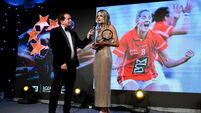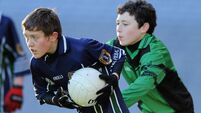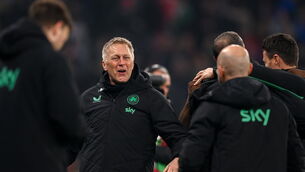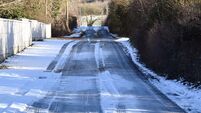Kieran Shannon: The difficulty of looking after number one
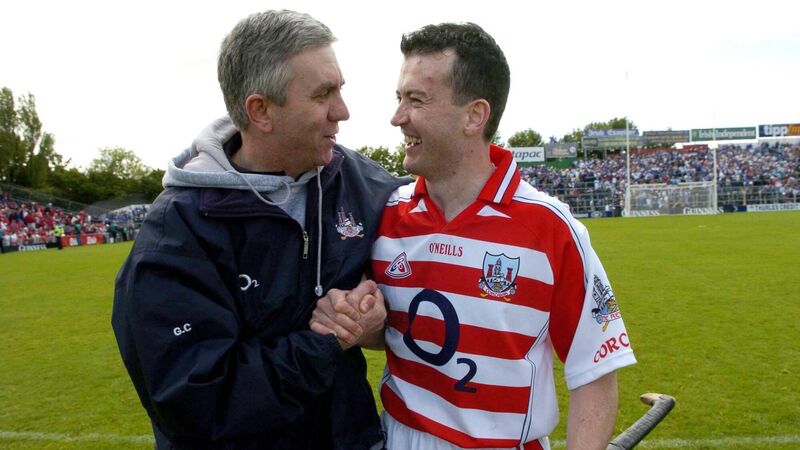
PASSING THE BATON: Donal Óg Cusack is congratulated by then Cork selector and former 'keeper Ger Cunningham after the 2005 Munster semi-final. Pic: Ray McManus/Sportsfile
If there’s one thing as challenging as replacing a long-standing number one, it can be having them still around the place when there’s a new number one in town.
Before there was Cluxton there was Cusack, another goalkeeper who changed not just how the position was played but the sport and the GAA itself on top of being the most commanding player in a dressing room for one of the most successful periods in his county’s modern history.
And before Cusack there was Cunningham, as in Ger, not so-much another long-serving goalkeeper as an institution. His first competitive game for Cork was back in the autumn of 1980 during a league campaign which would culminate with him claiming a winner’s medal. By 1998 he was still between the posts for his county and winning another league medal, which as it happens is the last any Cork netminder has claimed.
That winter though he retired, or was retired; exactly which has never been fully established. The previous two seasons the Cork U21s had won the All Ireland with Donal Óg Cusack between the sticks and having coached him to a minor All Ireland before that again Jimmy Barry-Murphy’s gut was telling him it was time to give Cusack his head even if it meant Cunningham’s rolling.
He and Cork and Cusack were blessed though that Cunningham rolled the way he rolled: the ultimate competitor yet ultimate gentleman. When Cusack first joined the senior panel in 1996 the first person to shake his hand and welcome him to the setup was Cunningham, then duly kept the kid from Cloyne stuck to the bench for the next three years. Then shortly after he announced that he was retiring from inter-county hurling, Cunningham would quietly return every evening to that Cork setup to help – push – Cusack.
“What an unreal thing to do after 18 years,” Cusack would write in his autobiography. “He might have sat on the bench so fellas could say to him, ‘Ah Ger, you should be in there.’ But he finished so I wouldn’t have that pressure. And then he helped me.”
Again, that meant sometimes cutting Cusack before then bandaging him. During the three years they were both on the panel – Cunningham the master, Cusack the apprentice – they would routinely have this game among themselves, or a slogging match as they used to call it. They’d put down two set of goals about 25 yards apart and hammer the ball at each other.
If you stopped the ball and it went out for a 65, you’d to strike the next ball off your left. And if the ball struck your body and you went down, you’d be ordered to get straight back up – or at least Cunningham would. “He would drive on, driving balls at me,” Cusack would recall.
Their most ferocious slogging match would be on the eve of Cusack’s championship debut. While everyone else would have wanted Cusack wrapped up in cotton wool, Cunningham, days before the first Cork team in 19 years to take to the championship field without him, “flaked the ball” continuously at Cusack. Then shortly before training wrapped up, he slipped away. When Cusack returned to the dressing room he found a note in his kitbag. “To the Number 1. Keep Your Eye On the Ball.”
Cusack would treasure and keep that card, sticking it up along with a picture of his grandmother in front of his mirror for as long as he lived at home with his parents. And it was a creed he would try to abide by himself when he was no longer the Cork number one. In the summer of 2012, a few months after his Achilles tendon had coiled up like a broken elastic band during a league semi-final, he brought Anthony Nash up to Croke Park for an All Ireland football quarter-final double-bill featuring one Stephen Cluxton so his replacement was more acclimatised to the place ahead of Cork’s upcoming semi-final against Galway.
Cork would lose that game but Nash would win an All Star, and that same winter Cusack would lose not just the team captaincy but his place on the panel. Although what had sustained him during his recovery was a shot at reclaiming the number one or at least number 16 jersey on the panel, Jimmy Barry-Murphy had made the calculation that Nash and the setup in general would be best served without Cusack hovering over their shoulder.
That is part of what makes Stephen Cluxton’s return so intriguing. Years after his departure from being a playing member of the Cork setup, Cunningham told Christy O’Connor in Last Man Standing, “I don’t think there would have been any benefit of having a 38-year-old goalkeeper sitting on the bench. I wasn’t going to put Donal Óg under the pressure of having me there and him looking over his shoulder.”
Yet that is precisely what Cluxton and Dessie Farrell – and you can bet Pat Gilroy and James McCarthy too – have done here. A 41-year-old who hasn’t trained or played with the county in over two years – last Sunday was sitting on the bench in Croke Park, looking out on David O’Hanlon. And as Farrell admitted, he hasn’t returned to just stay on that bench, or come off it only if O’Hanlon was to get injured. He’s returned to play, to take back that number one jersey.
A decade on and history still cannot decide if Barry-Murphy made the right calculation in opting to cut Cusack. Nash won a second All Star in 2013 and Cork were seconds away from winning the All Ireland. But would they have been even better served if Cusack was still around the place as he had been in 2012, helping with the video, offering little insights? Not so much keeping everyone on edge as keeping everyone on their toes? Would they have won that All Ireland replay and Liam MacCarthy itself?
Cluxton is a different personality; though were he to ever write an autobiography it could push or even eclipse Cusack’s as one of the best ever written by a GAA figure, he’s too reticent a figure to follow the Corkman’s example on that one. But like Cusack he was an enforcer of standards who was not afraid of confronting and challenging teammates and thus was somewhat feared by teammates.
Maurice Brosnan of this parish made a good point on Monday’s Irish Examiner podcast that you would think others like Ciaran Kilkenny and Brian Fenton would be able to enforce such standards; that the legacy of Cluxton would continue without him having to be necessarily there. The sense is he’s been invited back because with Evan Comerford out Dublin’s depth in the goalkeeping department isn’t as strong as it could be, for all O’Hanlon’s excellence and progress this spring.
Maybe like Cunningham with Cusack and then Cusack with Nash he’ll make O’Hanlon even better by his presence and guidance; drive him more than usurp or replace him. Either way it is a sure sign that Dublin are going all out this year to win it all.
The return of Paul Mannion and Jack McCaffrey were already signals that this was the year the band were all getting back together so they might as well bring back their frontman even if this time he might be on backing vocals. And whatever about being or replacing the number one, he’ll help them all keep their eye on the ball by keeping them all on their toes.

